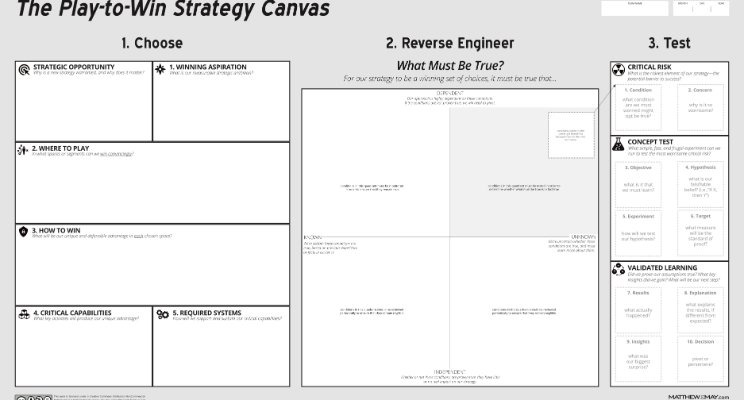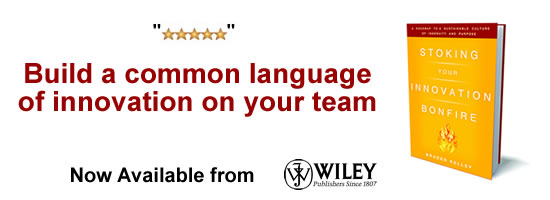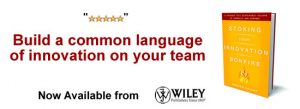The Play-to-Win Strategy Canvas v3.0

A little over four years ago I designed and developed a wall canvas to be used when facilitating strategic choice-making with small teams. Over time, the canvas has evolved as I learned more and more about the art and discipline of strategy facilitation…what people struggle with most, where the resource of time is best spent, etc.
Fast forward to now. I introduced v3.0 of the canvas a few weeks ago in a short post, but I thought I’d add a little content to both explain what’s different (and why) and a few tips.
The first thing you’ll notice is that strategy-making is in three big steps:
- Choose (strategic choices using the Play-to-Win framework)
- Reverse Engineer (what must true for the choices to be good ones)
- Test (validating what must be true is in fact true, or true enough)
This structure will aid you in allocating your time.
The second thing you notice is while the choice-making spaces are a bit smaller (by design), I’ve added a goodly piece of working space right in the middle of the canvas, for Reverse Engineering. It makes up the bulk of real estate, for one good reason: this is not only where the richest discussion happens, but it is also where strategy meets up with innovation. An innovative new strategy is just like a new product concept: you need to identify the critical risks and leap of faith assumptions you’re making in your bias for optimism around your great new strategy.
Here’s how the Reverse Engineering space works. The goal is to get to the single most critical risk of your strategy, which you get to in a few simple steps.
- Ask: What Must Be True? for your integrated set of choices to be successful. Ignore the grid axis for the time being. Consider all the choices you’ve made: spaces, advantages, capabilities, systems. Put each answer on a separate Post-It note and place it anywhere on the Reverse Engineering quadrant. You’ll undoubtedly have a dozen or more. Do NOT try to place them in the quadrants yet.
- Move everything you know to be true to the left hand side of the grid. The X-axis goes from “Certain” to “Uncertain.” So move everything you’re certain of over to the left, leaving you with all of your uncertainties to the right.
- Move all uncertainties upon which your strategy is dependent to the upper right quadrant. The Y-axis goes from “Dependent” to “Independent.” You’re looking for the things that must be true and if they aren’t your strategy is in jeopardy. In other words, the Uncertain Dependents.
- Decide which of your Uncertain Dependents is the most worrisome, and move it into the top righthand corner of the Uncertain Dependent quadrant. This is your Achilles heal, your most critical risk, your biggest assumption, your leap of faith. And it is around this that you want to construct your first test.
The third thing you’ll notice is more space devoted to crafting a strategic test, with more guidance. This is perhaps the toughest task for many teams, simply because much of the business world has forgotten how to run an experiment. It is here that strategy meets up with innovative lean thinking.
So, in a nutshell, v3.0 is far simpler, yet represents a better blend of strategic, innovative, and lean thinking.
I’m happy to answer any questions, just message me. In the meantime, please feel free to download and begin noodling with the canvas. I’ve created two sizes: a wall size and a person 11×17 size.
Download the free wall size canvas here.
Download the free 11×17 canvas here.
Let me know if/how you like it!
Wait! Before you go…
Choose how you want the latest innovation content delivered to you:
- Daily — RSS Feed — Email — Twitter — Facebook — Linkedin Today
- Weekly — Email Newsletter — Free Magazine — Linkedin Group
 Matthew E. May is the author, most recently, of Winning the Brain Game: Fixing the 7 Fatal Flaws of Thinking.
Matthew E. May is the author, most recently, of Winning the Brain Game: Fixing the 7 Fatal Flaws of Thinking.
NEVER MISS ANOTHER NEWSLETTER!
LATEST BLOGS
The Evil Downside of Gift Cards
This past holiday season I saw probably one too many articles trumpeting the value of gift cards to retailers and how they are a great thing for retailers. My skeptic side starts coming out as I see article after article appear, and I have to start asking “Is the increasing prevalence of gift cards as a holiday gift (primarily Christmas) a good thing for retailers?”
Read MoreWhy the iPhone will not succeed – Yet
The new Apple iPhone is set to launch on June 29, 2007 and the press and investors are making it a darling. Investors have run Apple’s stock price up from about $85 per share before its announcement to $125 per share recently, but the iPhone still will not succeed – at least not yet.
Read More




Your files cannot be downloaded. They go to a 404 link. Please send me an email with the 11 x 17. Thanks.
the files are not there anymore!
Getting a 404 error when I try to get the map.
The file download links are broken, the fils cannot be downloaded.
Hi Matthew, was not able to download either of the files. Please help to check link